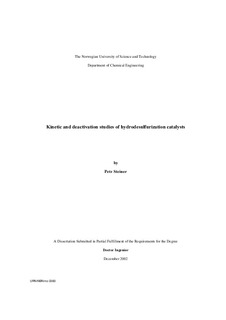| dc.description.abstract | Hydrodesulfurization is an important part of the hydrotreating process. More stringent regulations on the quality of fuels bring new requirements to the catalytic processes. The removal of sulfur has become a key issue in the oil refining and this work aims to address several aspects of the process.
Kinetic studies of the hydrodesulfurization reaction over conventional (molybdenum-based) and new (Pt/Y-zeolite) catalysts are reported. The hydrodesulfurization of both the real oil (light gas oil from Statoil Mongstad refinery) and model compounds (thiophene and dibenzothiophene) over a NiMo/γ-Al2O3 catalyst were studied. In a high-pressure study of the light gas oil, substituted alkyl-DBTs were found to be the most difficult to desulfurize and the order of reactivity was found to be DBT > 4-MDBT > 4,6-DMDBT. Steric hindrance together with electronic effects were identified as possible reasons for this behavior. The difference in reactivities of the individual compounds was found to decrease with the increasing reaction temperature. A gas chromatograph equipped with the atomic emission detector (GC-AED) was used for the analysis of the individual components of the oil.
The initial deactivation and the steady-state kinetics were studied during the HDS of thiophene at atmospheric pressure. Unpromoted Mo/γ-Al2O3, CoMo/γ-Al2O3, NiMo/γ-Al2O3, and phosphorus modified NiMo/γ-Al2O3 were used for the deactivation study, while NiMo/γ-Al2O3,CoMo/γ-Al2O3, and Pt/Y-zeolite (with three different pretreatments) were used for the steadystate study. Several experiments related to the deactivation of Mo/γ-Al2O3 and NiMo/γ-Al2O3 catalysts prepared with the chelating agent (NTA) were also performed and NTA was found to have no significant effect on the activity of the catalysts.
In the deactivation study, a fast initial decrease in the activity was observed on all the catalysts. However, nickel promoted catalysts were found to be more resistant to deactivation than unpromoted ones. The presence of phosphorus slightly increased the activity of the catalyst towards the thiophene HDS, but had no effect on the deactivation behavior. Several methods to regenerate the catalyst were investigated. During the resulfiding experiments, a difference between Mo/γ-Al2O3 and NiMo/γ-Al2O3 was observed. Deactivation of the Mo catalyst was more severe with increasing temperature, while for the NiMo catalyst the opposite behavior was observed. Carbon deposition on catalysts followed the similar trend: More carbon was observed on the Mo catalyst at higher temperatures, while the opposite is true for NiMo. The restoration of the activity of NiMo was complete, while the reactivation of the Mo catalyst was only partial. The results from the reactivation experiments with pure H2 and inert gas (helium) suggest that several mechanisms of the restoration of activity exist: Resulfiding of the desulfided active sites, hydrogenation and removal of the deposited carbonaceous species, and the desorption of the reactants and products from the active sites of the catalyst. Based on the observed results, the higher hydrogenation activity of nickel is assumed to be the reason for the behavior. Hydrogenation causes the faster removal of the deposited carbonaceous species and this leads to the conclusion that the desulfiding of the active sites and the adsorption of the reaction species is significantly less pronounced on the NiMo/γ-Al2O3 catalyst.
Characterization studies show differences between standard and NTA-based catalysts. The higher amount of carbon on the NTA catalysts is attributed to the presence of the carboncontaining precursor - NTA. The changes in the surface area and the pore volume were observed only during the sulfiding process. In the case of standard catalysts the surface area and the pore volume decreased, while for the NTA-based catalysts the opposite is true. No change in the surface area and the pore volume with the increasing time on stream indicates that the deactivation is not due to structural changes of the catalyst. The amount of sulfur was found to be constant during the time on stream for all the catalysts.
In the steady-state study of the HDS of thiophene, CoMo and NiMo catalysts were found to be equally active. The activity of the Pt/Y-zeolite catalyst was found to be comparable to conventional catalysts when based on the amount of active material, but a fast deactivation was observed. The product selectivities during the HDS of thiophene were found to be the same for all standard catalysts, but slightly different for the Pt/Y-zeolite catalyst. This was attributed to a higher hydrogenation activity of the Pt/Y-zeolite catalyst.
The inhibition effect of other sulfur compounds and aromatics on the high-pressure hydrodesulfurization of dibenzothiophene (DBT), the so-called “matrix effect” was studied. Thiophene and DMDS have the same inhibiting effect on the total conversion of DBT, but differences exist in the effect on the selectivities of the products at low concentrations. The results indicate that the inhibiting effect of H2S on the direct desulfurization route is stronger than the effect of thiophene on the hydrogenation pathway. In the study of aromatics, both toluene and naphthalene affect the total conversion of DBT. Naphthalene was found to be a much stronger inhibitor and inhibits mainly the direct desulfurization pathway, while the hydrogenation route is more affected by the presence of toluene. | nb_NO |
